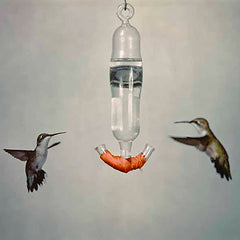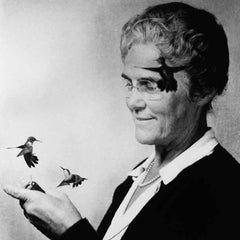Webster Hummingbird Feeder

In 1928, in Boston, Mr. and Mrs. Laurence Webster read Margaret Bodine’s accounts of attracting and feeding hummingbirds in National Geographic. The Webster's enjoyed watching hummingbirds in their gardens and decided to begin their own feeding experiments. Utilizing his engineering background, he drew plans and specifications for a hummingbird-feeding device to be created entirely out of blown glass.
Using the glass blowing laboratory at his alma mater, M.I.T., the chemistry and physics people who worked in the lab made a prototype model from a 5-inch section of glass tubing with a 1-3/4 inch diameter. The hot glass was shaped with a bulge in the center and two opposing upcurving food ports were formed from 1/2 inch tubing and attached. A glass eye-hook was formed at the top of the feeder for hanging purposes and Webster, after experimenting with several colors for the feeding tubes, decided on a gold-impregnated glass which we see as bright red.
About thirty of these blown-glass feeders were produced in the M.I.T. laboratories for the Webster's.
The Webster’s maintained a glorious estate near Cambridge, MA and a vast summer retreat in a New Hampshire. They had a large staff of gardeners to maintain several acres of flower gardens at each location. After church, on Sundays, they let the general public stroll the grounds for a few hours at no charge. As they had some of the largest flower gardens in all of New England, they also attracted large numbers of Ruby-throated hummingbirds each season. Their properties became known as the best locations in that region to observe hummingbirds.
Naturally, when the visitors saw the first hummingbird feeder, and how successful it was even surrounded by acres of nectar producing flowers, they wanted one for themselves. Hummingbird feeding was uncommon when Webster created his feeder, and sale of the feeder wasn't his intention.
However, the August, 1947 edition of National Geographic Magazine featured an article by Harold Edgerton. Included in the article were his photographs of hummingbirds, feeding at the Webster feeders, captured by his revolutionary invention-the strobe photo flash. Inquiries about the availability of the Webster feeder began arriving in the mail.
Mr. Webster had several hundred of these feeders created and sold them for $10.00 each (a lot of money back then!). When Mrs. Webster died in 1948, he created 500 more feeders and donated them to the Audubon Society in January of that year. National Geographic magazine featured pictures of the first hummingbird feeder being used in the February issue. The public clamored for the hummingbird feeders.
Thus, the first commercially available hummingbird feeder, ‘the Webster Hanging Feeder’ was introduced in 1950 by the Audubon Novelty Company of Medina, New York. Audubon’s mail order gift shop was offering the Webster Feeder for $3.00 which sold out within the month. They disappeared off the market until now reintroduced more than half a century later.
So 1950 marks the beginning of popular backyard hummingbird feeding as we know it today
We had a very talented local glass blower making these authentic reproductions for us and the birds seemed to enjoy using them. We sold them for $49.99. They were difficult to clean, they dripped and the bees had easy access to the nectar. We opted to discontinue sales.

Two hummingbirds appear still as they hover by a feeder, their wings beating at sixty times a second. This high-speed photograph (likely taken in 1938) was shot using an exposure of 1/100,000 of a second. Accurate observations of these birds' activities had eluded naturalists before the advent of flash photography. (CC)

An exposure of 1/100,000 of a second caught this 1936 picture of hummingbirds in action. Since their wings beat sixty times a second, accurate observations of hummingbirds; activities had eluded naturalists before flash photography. Edgerton's strobe revolutionized bird photography and dozens of his pictures appeared in NATIONAL GEOGRAPHIC MAGAZINE and naturalist publications. In this photograph the birds are humming around Mae [May] Webster, a hummingbird enthusiast and wife of MIT alumnus Laurence Webster (Class of 1898) whom Edgerton visited a number of times in Holderness, New Hampshire for his bird documentation work. (CC)
Condensation a result of just being filled with nectar from the refrigerator
